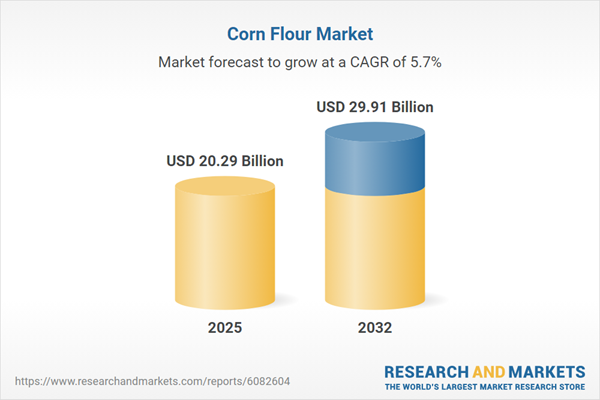Speak directly to the analyst to clarify any post sales queries you may have.
The corn flour market is entering a dynamic phase, with supply chain restructuring, consumer expectations, and new technologies shaping forecasts and procurement strategies for senior executives.
Corn Flour Market Snapshot
The corn flour market achieved growth from USD 19.19 billion in 2024 to USD 20.29 billion in 2025 and is predicted to reach USD 29.91 billion by 2032, corresponding to a CAGR of 5.69%. Growth is driven by corn flour’s broad use and processing adaptability across core end-use segments, including bakery, confectionery, snack foods, and animal feed. Manufacturers prioritize flexible processes and consistent formulations to align with shifting consumer preferences and evolving product innovations. Meanwhile, global supply chains must respond to regulatory changes, procurement risks, and the rising need for resilient and adaptive sourcing strategies.
Corn Flour Market Scope & Segmentation
- Application Areas: Bakery, confectionery, and snacks leverage corn flour’s unique texture and stability, fostering ongoing product innovation and meeting both traditional and emerging customer demands.
- Product Types: Offerings include white corn flour (in high-protein and regular options) and yellow corn flour (standard formulation), each addressing specific manufacturing and nutritional requirements.
- Distribution Channels: Channels range from bricks-and-mortar operations such as supermarkets, hypermarkets, and convenience stores, to digital platforms through direct sales and comprehensive e-commerce networks.
- Form Types: Both modified (acid-modified, pregelatinized) and native forms enable manufacturers to target functional performance, stability, and application-specific requirements.
- Grades: Coverage spans feed-grade corn flour for livestock and poultry, as well as food-grade types meeting quality standards for human consumption and diverse ingredient applications.
- Packaging Formats: Options include bulk (bags, drums) for industrial users and retail-ready (bottles, boxes, pouches) to optimize supply chain efficiency and store placement.
- Geographic Regions: The market encompasses the Americas, Europe, Middle East and Africa, and Asia-Pacific, reflecting variations in consumption patterns, regulatory environments, and market maturity.
- Key Companies: Leading suppliers such as Archer Daniels Midland Company, Cargill, Ingredion, Gruma, Bunge, Tate & Lyle, Roquette Frères, BENEO, Grain Processing Corporation, and MGP Ingredients demonstrate broad industry coverage and technical capability.
Key Takeaways for Senior Decision-Makers
- Adoption of processing technologies, including acid-modified and pregelatinized corn flour, allows for differentiation in application performance, supporting advanced product development and enhanced product quality.
- Rising consumer expectations continue to influence product portfolios, with more attention on clean label formulations, higher protein content, and gluten-free varieties in core categories.
- The growth of e-commerce and changing distribution priorities are pushing investments in flexible packaging and responsive last-mile delivery, balancing traditional retail strength with new digital potential.
- Sustainability and traceability standards are key in supplier selection, with buyers seeking transparent sourcing and packaging solutions that meet recycling and regulatory criteria across regions.
- Regional supply chain strategies must balance established integration in North America with faster demand shifts in Asia-Pacific, making sourcing flexibility and localization critical for market success.
- Upstream integration and collaborative product innovation are increasingly essential, securing access to corn supplies and enabling quick adaptation to demand and regulatory dynamics along the value chain.
Tariff Impact: Navigating U.S. 2025 Adjustments
Anticipated changes to U.S. tariffs in 2025 are prompting procurement teams to reassess sourcing and risk management. Many buyers are increasing domestic procurement and strengthening local milling operations to reduce exposure. Strategies now include employing contingency clauses, hedging tools, and reviewing supplier relationships. Manufacturers are optimizing logistics networks and, where required, adjusting formulations to mitigate input cost volatility. This shift enhances value chain efficiency through nearshoring and vertical integration, while supporting more reliable product delivery and lessening transportation-related vulnerabilities.
Methodology & Data Sources
This report is based on a mixed-methods research approach, including interviews with major ingredient buyers, process engineers, and commercial leaders. Direct field observations and rigorous application trials are combined with systematic secondary analysis from regulatory and technical literature, and findings have undergone validation by industry experts.
Why This Report Matters
- Offers actionable segmentation insights that help executives optimize portfolios, application approaches, and channel strategies in an evolving corn flour sector.
- Provides a framework to address ongoing challenges in regulation, procurement, and innovation, supporting informed commercial and operational planning.
- Delivers practical intelligence for strengthening supply continuity and responsiveness amid shifting supply chain and market environments.
Conclusion
Corn flour remains central to multiple industries as the market adjusts to continual innovation and changing supply requirements. Aligned sourcing, channel diversification, and sustainability efforts will support executives in capturing opportunity and reinforcing operational performance.
Table of Contents
3. Executive Summary
4. Market Overview
7. Cumulative Impact of Artificial Intelligence 2025
Companies Mentioned
The companies profiled in this Corn Flour market report include:- Archer Daniels Midland Company
- Cargill, Incorporated
- Ingredion Incorporated
- Gruma, S.A.B. de C.V.
- Bunge Limited
- Tate & Lyle PLC
- Roquette Frères S.A.
- BENEO GmbH
- Grain Processing Corporation
- MGP Ingredients, Inc.
Table Information
| Report Attribute | Details |
|---|---|
| No. of Pages | 193 |
| Published | November 2025 |
| Forecast Period | 2025 - 2032 |
| Estimated Market Value ( USD | $ 20.29 Billion |
| Forecasted Market Value ( USD | $ 29.91 Billion |
| Compound Annual Growth Rate | 5.6% |
| Regions Covered | Global |
| No. of Companies Mentioned | 11 |









